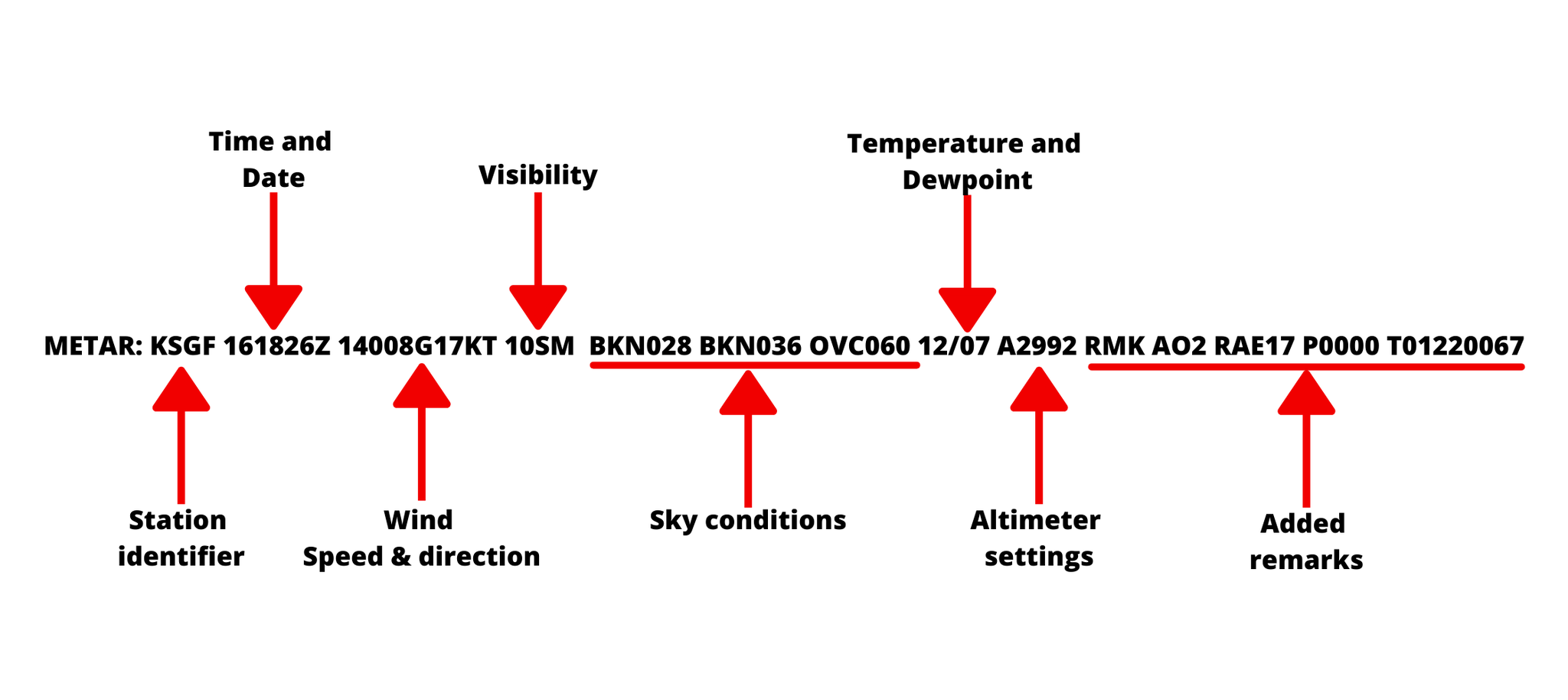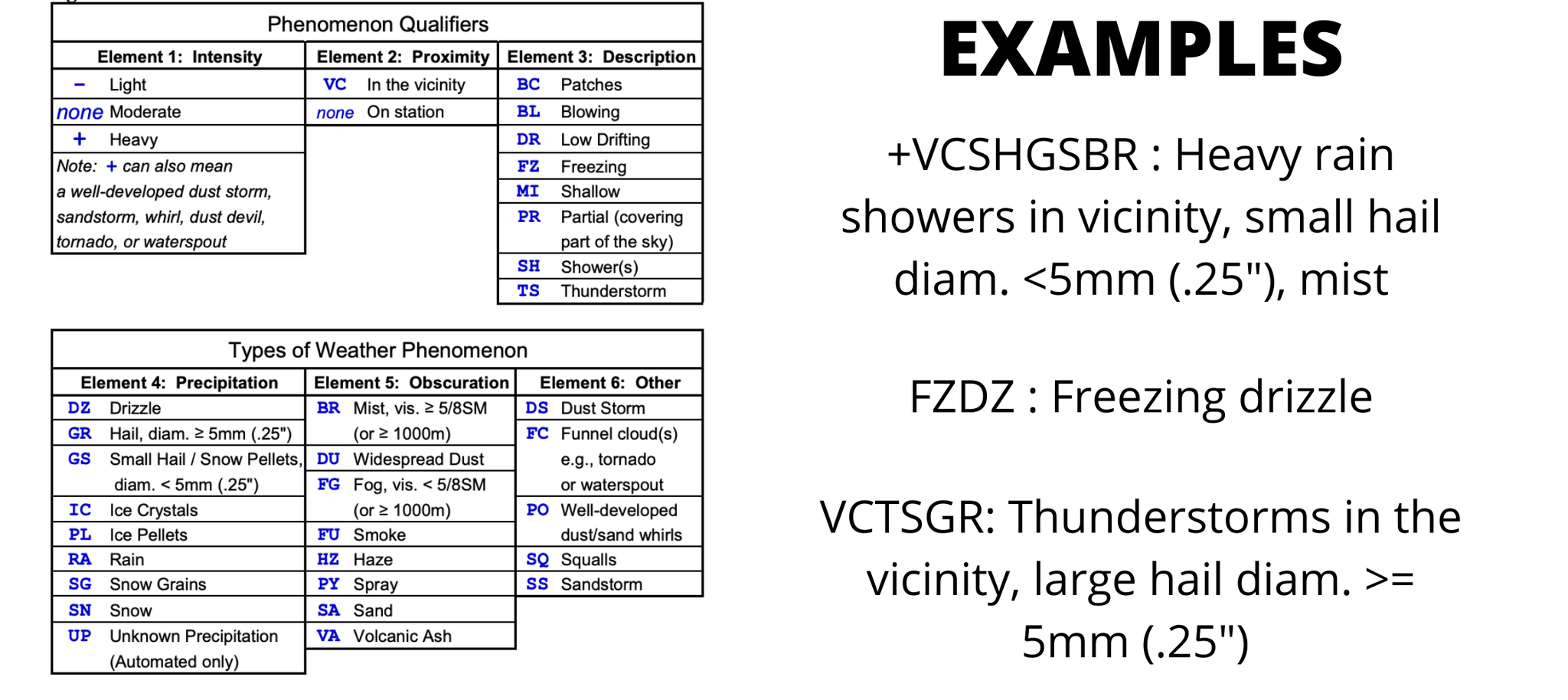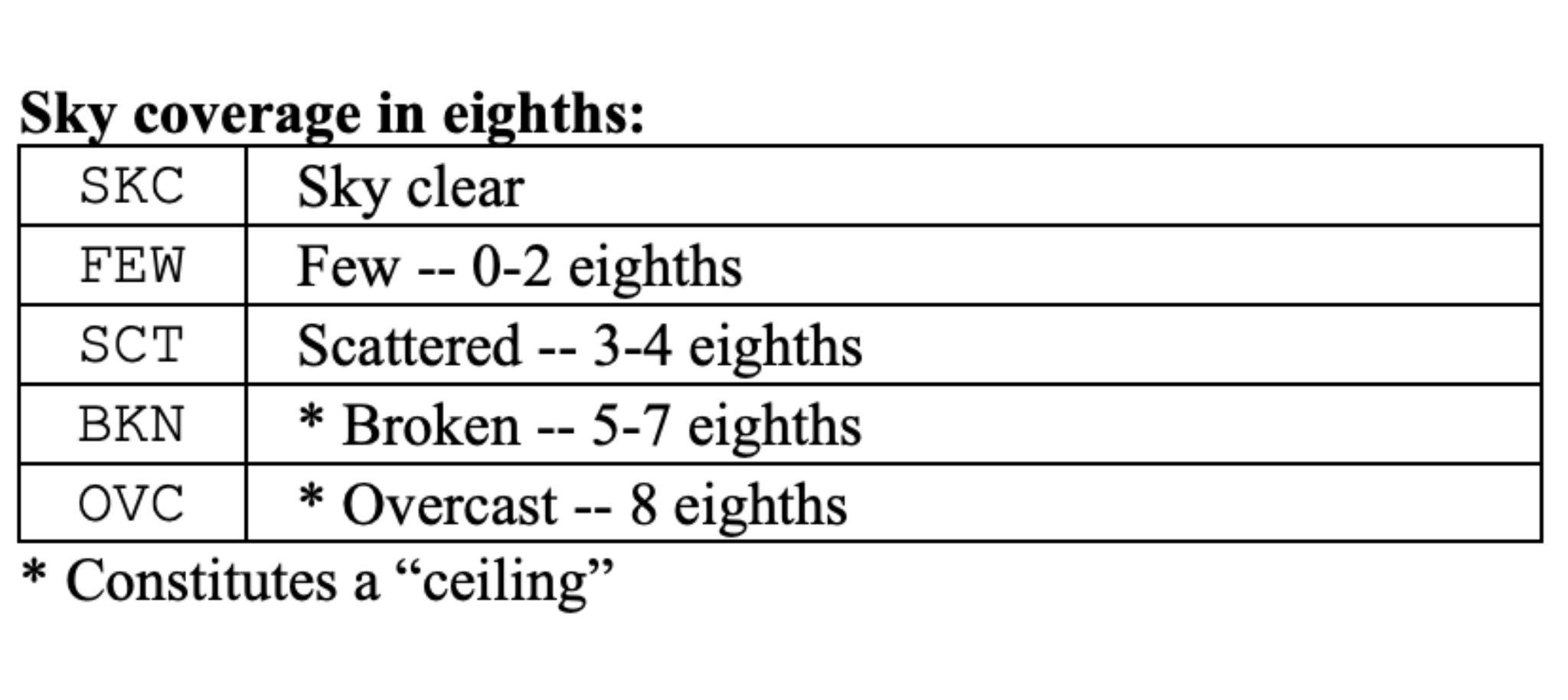Meteorologists' Secret Code
Alright, it’s not really a secret code, but if you see this, “KSGF 161826Z 14008G17KT 10SM BKN028 BKN036 OVC060 12/07 A2992 RMK AO2 RAE17 P0000 T01220067,” yeah, you may think there is confidential information in there. Well, that "secret code" is known as a METAR.
METAR is roughly translated from French as Aviation Routine Weather Report. As the name suggests, the reports are essential for airline pilots and give updated weather information.
So this, “KSGF 161826Z 14008G17KT 10SM BKN028 BKN036 OVC060 12/07 A2992 RMK AO2 RAE17 P0000 T01220067,” is similar to me giving a forecast on the green screen, but with a lot less ad-lib and no futurecast information.
What is a METAR?
METAR is a shorthand version of observed weather conditions for meteorologists and aircraft pilots. METAR reports are issued every hour unless there is inclement weather, in which case special METAR reports are released.
For pilots, knowing weather information is critical. Strong winds, hail, downdrafts, and icing of plane wings all have the potential to take an airplane out of the sky. Pilots must know about weather forecasting and have a way to receive current weather reports, which is where METARs come in.
How to read this secret code
METAR: KSGF 161826Z 14008G17KT 10SM BKN028 BKN036 OVC060 12/07 A2992 RMK AO2 RAE17 P0000 T01220067
All those letters and numbers in the METAR report are shorthand ways of writing things like wind speeds, weather conditions, visibility, sky conditions, temperature, and dewpoint.
Using the METAR report from above as an example, the abbreviations can be translated to the following:
Springfield, MO, April 16th at 1:26 pm. Winds are coming from the southeast at 8 knots (9 mph) with gusts of 17 knots (19 mph). Visibility is 10 miles. Broken clouds at 2,800 feet. Broken clouds at 3,600 feet. Overcast at 6,000 feet. Temperature is 12° C (53° F), with a dewpoint of 7° C (45° F). Pressure is 29.92 inches of mercury. Remarks: Automated & has a precipitation sensor, the rain ended 17 minutes past the hour, 0 inches of rain, the temperature is 12.2° C and dewpoint is 6.7° C.
Lots of information packed into those codes, right? Now you see why we have them?
Going section by section, I'm going to break down what each code means. You can use the image below as an easy reference point.

METAR Station identifier - KSGF
K refers to the continental United States. SGF is the location of the airport. In our case, this is the Springfield-Branson airport.
Time and Date - 161826Z
The first two digits are the day of the month, and the second four numbers are the time. Notice how a number corresponding to the month and year is not displayed?
18:26Z, this is almost a code in itself. Z stand for Zulu or UTC. Zulu time works on the 24-hour clock, similar to military time. The difference between Zulu and military time is with Zulu, the midnight hour is based on local time at the 0-degree longitude of the prime meridian, which is in Greenwich, England. The prime meridian is the line that divides Earth into the Eastern Hemisphere and Western Hemisphere.
Modifier- COR or AUTOWind Speed - 14008G17KT
A METAR may display COR or AUTO. These codes let you know whether the report is corrected (COR) or from an automated station (AUTO). In our METAR above is an automated report. Notice how the word AUTO is not included in the report?
Wind Speed - 14008G17KT
Now to the 5th section of the METAR code, 14008G17KT. The first three numbers, 140, refer to the direction of the wind in degrees. We have a southeast wind. The second two numbers, 08, refers to the wind in knots.
Knots is the unit of speed equal to one nautical mile per hour. Knots are the preferred unit for measuring winds and can convert to miles per hour. For our METAR, 8 knots is about 9 mph. G refers to wind gusts, which in this case is 17 knots or about 19mph.
Visibility - 10SM
Just like how drivers need to know visibility on the road, it’s equally, if not more important, for pilots to receive visibility reports. For our METAR example, 10SM refers to the visibility of 10 miles. SM stands for STATUTE MILES. Statute miles is just our regular mile, 5,280 feet which are based on paces. Nautical miles refer to a mile on the water, where you cannot measure paces.
Weather

In our example of the METAR report, there are no reported weather conditions. If there were storms or something similar in the vicinity of the airport, it would be in this section. The intensity of the precipitation is denoted by (-) for light, () for moderate, (+) for heavy. RA stands for rain, GR stands for hail, SN stands for snow. If inclement weather is within 5 or 10 miles of the airport, the abbreviation for vicinity (VC) would be listed.
Sky conditions - BKN028 BKN036 OVC060

Next, we look at the sky conditions and if there are any obscurations. 028 is short for 2,800 ft, so we have broken (BKN) clouds at 2,800 ft above ground. We also have broken clouds at 3,600 ft and overcast clouds at 6,000 ft. The code OVC stands for overcast skies, SCT means scattered clouds, etc.
Temperature/Dewpoint - 12/07
From our example, 12/07, the first number is the temperature in degrees Celsius, and the second number is dewpoint. You can learn about the conversions between Celsius and Fahrenheit by clicking HERE, and review a breakdown of what dewpoint means by clicking HERE. 12° C is 53° F, and 7° C dewpoint is 44° F.
Altimeter settings - A2992Added remarks
A2992 is the altimeter reading, where A stands for altimeter, and 29.92 is the pressure in inches of mercury. Pilots will set their altimeter to this pressure.
Added remarks
This section can include any added data such as wind, variable visibility, when rain may end, more pressure information, etc. For our METAR:
RMK - remarks
AO2 - Automated and has a precipitation sensor
RAE17 - Rain ended 17 minutes past the hour. Would also be used to describe when other precipitation ended.
P0000 - hourly precipitation in hundredths of an inch. 0 for our case.
T01220067 - More detailed hourly temperature and dewpoint in tenths degrees C. So, 22.0° C, and a dewpoint of 6.7° C.
Alright, now you practice! We have a great METAR from April 20th when snow was moving through.
KSGF 201902Z 34009KT 3/4SM -SN BR VV008 00/M01 A3016 RMK AO2 P0001 T00001006
Think you can break it down? Give it a try, then check yourself using this METAR decoder website by clicking HERE.

0 Comments Add a Comment?